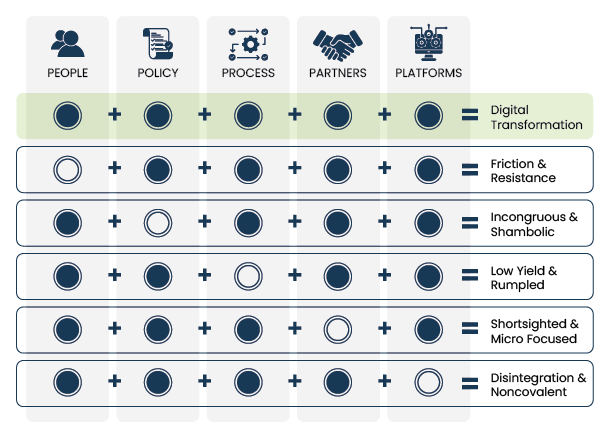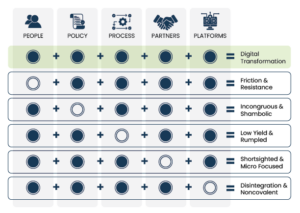The federal landscape is undergoing a significant shift towards digital excellence. From streamlining citizen services to enhancing agency operations, digital initiatives are a necessity for government organizations to keep pace with the evolving landscape. However, navigating digital excellence, and by association digital transformation, can be complex. While many leaders focus on the technology itself, neglecting the human element and crucial operational changes can lead to project failure. The ripple effect of that failure is felt by internal and external users, stakeholders, the mission suffers, time is lost, let alone taxpayer funding is wasted. A successful digital transformation requires a holistic approach that considers five key pillars: People, Policy, Process, Partners, and Platforms, what I call the 5Ps.
The 5Ps: Building a Strong Foundation for Digital Transformation
Each P represents a crucial element that, when integrated effectively, fosters successful digital transformation. Conversely, neglecting any one of these Ps can cause friction and resistance, leading to a project that is incongruous, low-yielding, shortsighted, or even disintegrates altogether.

“When digital transformation is done right, it’s like a caterpillar turning into a butterfly, but when done wrong, all you have is a really fast caterpillar.” – George Westerman | Principal Research Scientist, MIT Sloan Initiative on Digital Economy
Let’s delve deeper into each P to understand their significance and the potential pitfalls of overlooking them:
1. People: The Human Center of Transformation
At the core of any digital transformation initiative are the People. This encompasses leaders, employees, citizens, and other stakeholders. Their buy-in, skills, and capabilities are paramount. Effective communication, training, and change management are crucial to ensure everyone understands the digital project’s goals and how their roles will evolve.
What happens when you neglect People?

- Resistance to change from employees who fear job displacement or whose skills are not aligned with the new technologies.
- Lack of user adoption for new applications or systems.
- Talent gaps due to a lack of upskilling or reskilling initiatives.
2. Policy: Setting the Guideposts
Policy provides the guardrails that govern how digital transformation is implemented. This includes directives, guidance, and procedures that address data privacy, security, and IT infrastructure management. Federal agencies must adhere to specific legislative and compliance requirements, and policies must be developed to ensure digital initiatives align with these requirements.
What happens when you neglect Policy?

- Non-compliance with federal regulations leading to project delays or shutdowns.
- Unclear decision-making processes hinder progress.
- Security breaches and data leaks due to inadequate protocols.
3. Process: Optimizing Workflows
Process refers to the business workflows that will be transformed through digital initiatives. Federal agencies often have legacy systems and paper-based processes that can be inefficient. In some cases, they digitized a paper process, and now there’s an opportunity to improve the digital process through automation. Digital transformation is an opportunity to streamline these processes and leverage technology to enhance efficiency and accuracy.
What happens when you neglect Process?

- Inefficient workflows that continue to burden employees and hinder productivity.
- Incompatibility between new technologies and existing processes, creating bottlenecks.
- Failure to realize the full potential benefits of digital transformation.
4. Partners: Collaboration is Key
Partners play a critical role in digital transformation. This includes internal and external partners, such as academia, industry experts, and technology vendors. Collaboration with these partners can provide access to specialized skills, knowledge, and innovative solutions. This collaboration also ensures their needs or requirements are incorporated into the digital transformation.
Federal CIO Clare Martorana emphasized “The success of digital transformation efforts will depend heavily on how well agencies collaborate across functions and with external partners.”
What happens when you neglect Partners?

- Re-inventing the wheel by attempting to develop solutions in-house that already exist.
- Lack of access to cutting-edge technologies and expertise.
- Siloed efforts that hinder information sharing and collaboration.
5. Platforms: The Technological Foundation
Platforms encompass an organization’s existing technologies, software, applications, and infrastructure that will be leveraged or replaced during digital transformation. A thorough assessment of current IT infrastructure is essential to determine compatibility with new technologies and to identify any upgrades needed.
What happens when you neglect Platforms?

- Investing in new technologies that are incompatible with existing infrastructure, leading to integration challenges.
- Security vulnerabilities due to outdated or unsupported technologies.
- An inability to scale digital initiatives to meet future demands.
“…we will be able to target the right investments to support digital delivery, consolidate and retire legacy websites and systems, work with our private sector partners to implement leading technology solutions, maximize the impact of taxpayer dollars, and deliver a government that is secure by design and works for everyone.” – Federal Chief Information Officer Clare Martorana

By focusing on the 5Ps—People, Policy, Process, Partners, and Platforms—federal leaders and buyers can establish a strong foundation for successful digital transformation and achieve digital excellence. A well-coordinated approach considering these interconnected elements will help ensure projects are implemented effectively, deliver meaningful benefits, and position agencies to thrive in the digital age.




